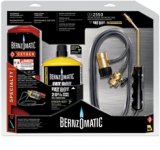1965_MGB
Jedi Warrior
Offline
While browsing around my local HD store, I came across a Bernzomatic cutting, welding, and brazing kit. It has two tanks of fuel, and the hoses,etc.
I was wondering if anyone has had any luck with one of these. I would like to invest in a better setup of course, but one must choose their battles wisely, if you catch my meaning.
I have enclosed a pic of what I was looking at.
I was wondering if anyone has had any luck with one of these. I would like to invest in a better setup of course, but one must choose their battles wisely, if you catch my meaning.
I have enclosed a pic of what I was looking at.

 Hi Guest!
Hi Guest!

 smilie in place of the real @
smilie in place of the real @
 Pretty Please - add it to our Events forum(s) and add to the calendar! >>
Pretty Please - add it to our Events forum(s) and add to the calendar! >> 

